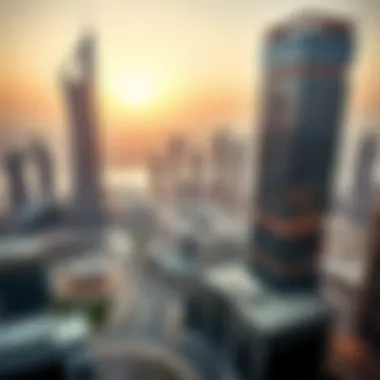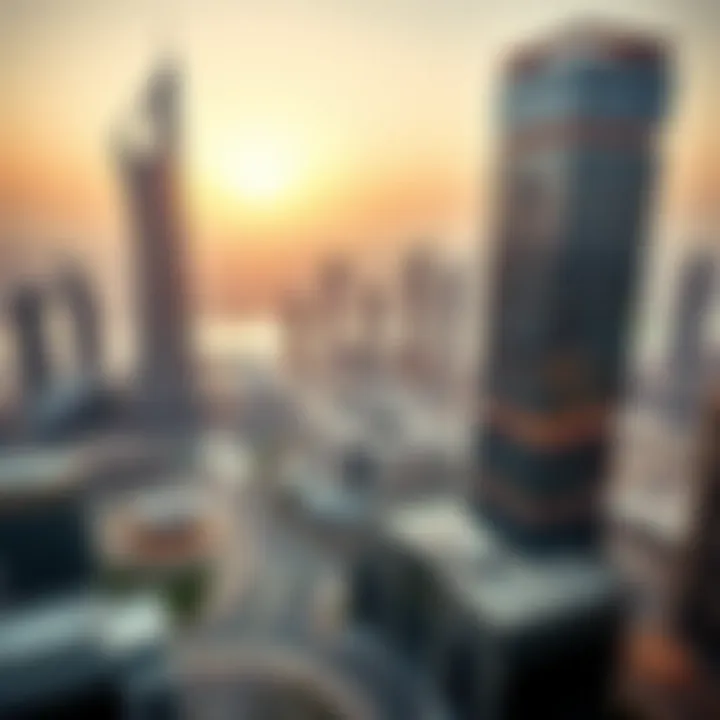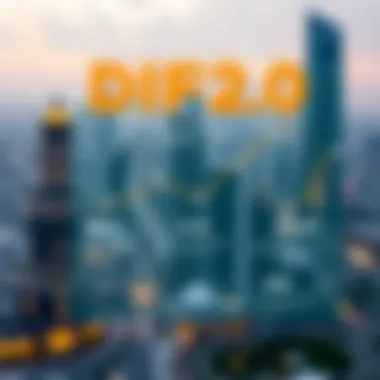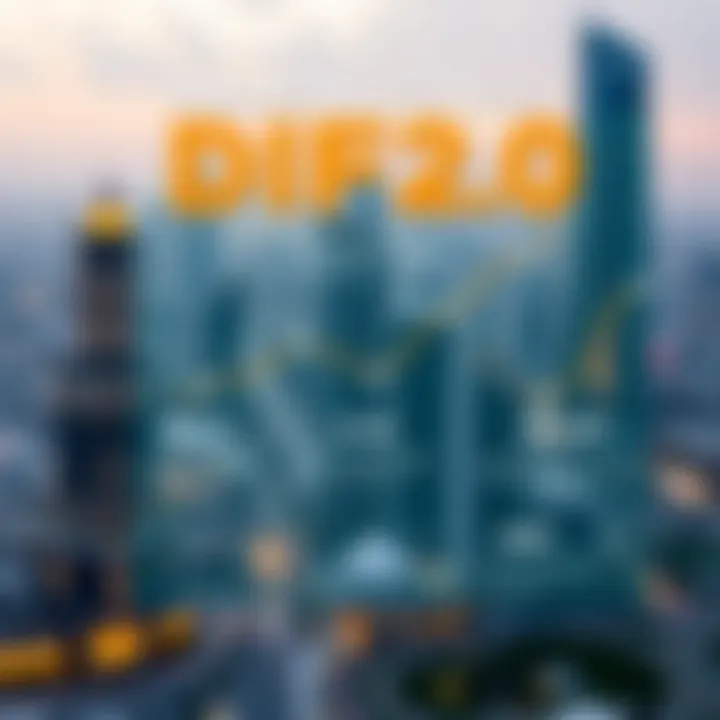DIFC 2.0: Impact on Dubai's Real Estate Market


Intro
The Dubai International Financial Centre (DIFC) has long been a cornerstone of the UAE’s financial sector, representing not only a hub for financial services but also an increasingly pivotal player in the real estate market. With the upcoming rollout of DIFC 2.0, the landscape is getting a fresh coat of paint. This new initiative isn’t merely a facelift; it aims to redefine how business, investment, and living spaces integrate in the heart of Dubai.
DIFC 2.0 promises enhanced regulations and improved infrastructure that could significantly impact homebuyers, investors, real estate agents, and developers. This comprehensive analysis aims to distill the important elements of this initiative and explore how it is poised to influence the real estate sector.
Market Trends
The real estate market in Dubai has been a rollercoaster ride over the past few years. Shifting economic tides, evolving consumer preferences, and new regulatory frameworks have all played a role in this dynamic ecosystem.
Current Real Estate Landscape
As of now, Dubai’s real estate market is characterized by a mix of high-end luxury developments and emerging affordable housing projects. The DIFC area itself continues to attract international firms and affluent expatriates seeking both commercial and residential offerings. Developments in the region reflect a strong focus on sustainability and smart technology, making them attractive to modern buyers.
Key aspects of the current landscape include:
- High Demand for Mixed-Use Developments: Projects combining residential, commercial, and leisure spaces are becoming popular, appealing to a diverse demographic.
- Increase in Affordable Housing: Developers are beginning to shift their focus towards affordable options to attract a broader audience.
- Regulatory Clarity: The local government’s emphasis on transparency and ease of doing business has encouraged foreign investment.
Future Predictions and Insights
Looking ahead, the DIFC 2.0 initiative is expected to create seismic shifts in the market. Experts forecast an uptick in foreign investments, particularly from emerging markets. With a renewed focus on lifestyle integration, the DIFC area may see the development of vibrant community spaces that cater to all facets of life.
Some future trends that could emerge include:
- Tech-Driven Properties: As smart homes gain traction worldwide, expect properties equipped with innovative technologies to dominate the market.
- Sustainability Initiatives: Projects emphasizing green building practices will likely secure financing and support from an increasingly eco-conscious investor base.
- Enhanced Networking Opportunities: The regulatory changes under DIFC 2.0 may foster greater collaboration between sectors, compelling real estate developers to form strategic partnerships with tech and financial institutions.
"DIFC 2.0 is not just an upgrade; it’s an opportunity for all stakeholders to rethink investment and living in Dubai, paving the way for the next generation of real estate."
Investment Strategies
With the evolving market landscape, savvy investors must rethink their strategies to harness the opportunities that DIFC 2.0 presents.
Smart Property Investments
Stakeholders looking to invest in real estate should focus on mixed-use properties that offer versatility and cater to a range of needs. Properties integrated into master-planned communities with a blend of residential and commercial offerings present promising opportunities. Further, an analysis of market demand, especially for affordable housing, reveals a ripe area for investment.
Aspects to consider include:
- Location: Proximity to commercial hubs, public transport, and amenities.
- Development Potential: The land's potential for future appreciation in value.
- Regulatory Environment: Understanding the impacts of DIFC 2.0 on property regulations and compliance.
Financing Options for Investors
Understanding the financing landscape is crucial for effective investment. Various options are available for investors, ranging from traditional mortgages to leveling into innovative financing methods like crowdfunding.
- Mortgages: Traditional financing remains popular, but keep an eye out for new lenders focusing on the DIFC region.
- Crowdfunding Platforms: This innovative approach allows smaller investors to pool resources into larger projects.
- Real Estate Investment Trusts (REITs): An indirect way to invest in real estate without owning physical property.
In navigating the DIFC 2.0 era, investors are urged to remain vigilant and adaptive to the fast-changing landscape. Armed with insights and strategic foresight, they can leverage the transformative potential of Dubai’s real estate market.
Understanding DIFC 2.
A look at DIFC 2.0 is crucial for anyone interested in the intricacies of Dubai’s real estate. The Dubai International Financial Centre has redefined its mission, adapting to the dynamic global landscape while carving out a niche for itself. Understanding DIFC 2.0 means diving into the synergy between its regulatory framework, economic vision, and enhanced infrastructure. This transformation opens doors for investors, developers, and future homeowners, making it essential to grasp the implications it carries.
Historical Context
To truly appreciate DIFC 2.0, one must consider its roots. Established in 2004, the original DIFC was a groundbreaking initiative aimed at providing a world-class environment for financial services. Over the years, it has attracted a variety of businesses, becoming a financial hub that caters to both regional and international markets. However, as the tides of global finance shifted, the necessity for DIFC to evolve became paramount. The latest iteration, known as DIFC 2.0, reflects lessons learned and anticipates future trends, establishing a more robust legal and economic framework.
The historical backdrop serves not just as context; it reveals a pattern of growth driven by adaptability. Investors looking to navigate this landscape need to understand where DIFC has come from to fully grasp where it is headed.
Key Objectives
DIFC 2.0 outlines several critical objectives aimed at enhancing Dubai’s positioning as a global financial center:
- Strengthening Dubai's Economic Resilience: One of the primary aims is to strengthen the economy against global uncertainties. The revision of the regulatory framework will help attract diverse businesses, promoting stability through a wider tax base.
- Fostering Innovation: A renewed commitment to innovation is essential. DIFC 2.0 seeks to promote new financial technologies, ensuring that Dubai remains competitive in the ever-evolving financial landscape. This positions DIFC as a launchpad for fintech startups and disruptive technologies.
- Enhancing Quality of Life: Beyond commercial interests, DIFC 2.0 also aims to improve the lifestyle of its residents and visitors. This includes developing residential spaces and leisure facilities to create an attractive urban environment, which may be a draw for expatriates and local residents alike.
- Promoting Sustainability: In a world increasingly focused on sustainability, DIFC 2.0 incorporates green initiatives within urban planning, ensuring that future developments align with global environmental standards.
Understanding these key aims allows stakeholders to evaluate not just the current opportunities but future shifts that DIFC 2.0 is poised to influence in Dubai’s bustling real estate landscape.


"DIFC 2.0 isn't just about economic metrics; it's a holistic approach to creating a vibrant community that balances commercial interests with social needs."
The Strategic Vision of DIFC 2.
DIFC 2.0 embodies a transformative approach to the Dubai International Financial Centre, bringing a refreshed perspective and an innovative path forward for business and the real estate market. Understanding this strategic vision is crucial for stakeholders including investors, developers, and homebuyers, as it reflects the overall direction and ambition of Dubai as a global business hub. The strategic vision aims not just at enhancement of the financial sector but at creating a robust infrastructure that supports holistic community development, hence fostering a conducive atmosphere for both local and international entities.
Alignment with Dubai’s Economic Agenda
The alignment of DIFC 2.0 with Dubai's broader economic agenda sets it apart as an initiative that goes beyond mere real estate growth. It is a concerted effort to reinvigorate the emirate's position as a premier business destination. By focusing on sectors like finance, technology, and innovation, DIFC 2.0 is designed to dovetail with the objectives laid out in documents like the Dubai Economic Agenda.
Investment in different industries ensures diversification and mitigation of risks associated with over-reliance on sectors such as tourism and hospitality. Moreover, attracting foreign direct investment becomes smoother due to regulatory harmonization and simplified procedures, which are central to the DIFC’s strategic vision. This alignment not only uplifts the financial industry but also contributes to crucial areas like employment and skill development within the community, encouraging a more educated workforce.
Vision for Future Development
The vision for future development under DIFC 2.0 exemplifies a commitment to sustainability and innovation, addressing current challenges while anticipating future needs. This includes the development of smart buildings, advancements in green technologies, and greater emphasis on pedestrian-friendly urban designs. Furthermore, the DIFC is working towards establishing itself as a center for fintech development, appealing to a younger generation of professionals seeking modern and tech-driven work environments.
Key aspects of this vision include:
- Sustainability Efforts: Projects are increasingly incorporating eco-friendly materials and energy-efficient designs, aligning with global expectations of sustainability in urban development.
- Smart City Initiatives: Integrating technology into everyday operations and infrastructure enhances the overall efficiency of the financial district while providing facilities that cater to the tech-savvy populace.
- Community Engagement: Future developments aim to encourage community interaction, providing spaces for social gatherings, events, and creative endeavors.
As DIFC evolves, it continues to draw attention to the need for adaptable strategies that can respond to economic fluctuates while anticipating demographic shifts. By keeping a keen eye on future needs, DIFC 2.0 promises innovations that reverberate throughout Dubai’s real estate landscape.
"DIFC 2.0 is not just a rebranding. It's a foundational shift aimed at positioning Dubai to thrive in a complex global economy."
In summary, the strategic vision of DIFC 2.0 is pivotal in shaping the trajectory of Dubai’s economy, ensuring that the emirate not only remains relevant but competitive on an international scale.
Regulatory Changes Under DIFC 2.
The regulatory landscape of the Dubai International Financial Centre (DIFC) 2.0 represents a significant shift in how the financial district operates. This section delves into the nuances of these changes and their subsequent effects on the real estate market in the region. It’s crucial to understand that these updates are designed not merely to address existing gaps but to enhance Dubai's position as a global financial hub.
Updated Legal Framework
One of the most notable aspects of DIFC 2.0 is the revamped legal framework. The reforms intend to offer a more robust and transparent governance structure, which is vital for fostering an environment conducive to business. Key changes in this legal framework include:
- Streamlined Licensing Procedures: The new framework simplifies the processes for obtaining licenses, thus allowing businesses to initiate operations more swiftly.
- Enhanced Dispute Resolution Mechanisms: Companies can now benefit from improved arbitration and mediation services, making it easier for disputes to be resolved outside of traditional court environments.
- Intellectual Property Provisions: As the DIFC aims to attract innovative firms, there's now an emphasis on protecting intellectual property rights, which can enhance the investment appeal for tech-related firms.
These legal enhancements, however, come with their own intricacies. Businesses need to adapt to the updated laws, ensuring compliance. Non-compliance could potentially lead to punitive measures, underscoring the necessity for all stakeholders to stay informed of each regulation related to their operations.
Implications for Investors
The implications for investors stemming from these regulatory changes are substantial. For real estate investors in particular, the new laws can be a double-edged sword. On one hand, the clarity and transparency offered by the updated framework can potentially drive up investor confidence. On the other hand, the need for rigid compliance may require a more sophisticated understanding of local regulations, adding complexity to investment strategies. Key considerations for investors include:
- Foreseeing Market Trends: With a clearer legal backdrop, forecast accuracy regarding property values is likely to improve, allowing investors to make better-informed decisions.
- Attraction of Global Talent: As DIFC becomes more appealing due to these regulations, businesses are likely to set up shop there. This influx could lead to increased demand for commercial spaces and residential properties.
- Risk Assessments: Investors must now carry out more thorough risk assessments as regulatory changes can influence market dynamics, possibly affecting yields.
The introduction of a more sophisticated legal framework under DIFC 2.0 is a movement toward establishing a balance where both business operations and stringent regulations can coexist.
Infrastructure Enhancements in DIFC 2.
The evolving landscape of Dubai's real estate is significantly influenced by the infrastructural advancements associated with DIFC 2.0. These developments are not just about erecting new buildings; they encompass a broader vision that integrates state-of-the-art facilities and improved transport links. The enhancement of infrastructure is pivotal for elevating Dubai's status as a global finance and business hub.
One key aspect of these enhancements is the strengthening of transport connectivity, which directly affects accessibility for residents and businesses. Improved public transport not only makes it easier for commuters to reach their destinations but also helps foster an environment where businesses can thrive. Enhanced transport systems often go hand-in-hand with increased property values, benefiting investors in the process.
Transport Connectivity
Transport connectivity within and around DIFC is a cornerstone of its infrastructure development. The introduction of new metro lines, better bus services, and dedicated bike lanes complements the already robust transportation network. With the rise of electric and shared mobility, options are expanding, bringing not only convenience but also sustainability.
Moreover, the addition of amenities like pedestrian pathways that are well-lit and landscaped encourages people to explore the area.
Key benefits include:
- Reduced Traffic Congestion: Improved transport links minimize reliance on cars, which is crucial given Dubai's traffic concerns.
- Increased Foot Traffic: With more people able to access DIFC easily, businesses can expect higher customer turnout, which can translate to greater revenue.
- Enhanced Property Value: Properties located near well-connected transport facilities typically see an upturn in value, positioning them favorably in the market.
A more connected DIFC directly attracts both expatriates and local investors, who are keen on making their mark in a shifting real estate climate.
Urban Development Initiatives
Closely related to transport upgrades, urban development initiatives form an integral part of the infrastructural improvements in DIFC 2.0. These initiatives are designed to enrich the urban fabric of the area, providing a blend of business, lifestyle, and leisure spaces that cater to a diverse demographic.


This includes the development of green spaces, parks, and community hubs that offer respite from the fast pace of urban life. There's a palpable emphasis on creating a livable environment, a balance of professional and personal lives. Such developments are fostering a sense of community that encourages collaboration and innovation.
Considerations on Urban Development Include:
- Sustainability Practices: Modern developments are increasingly focusing on eco-friendly designs, incorporating renewable energy sources and sustainable materials.
- Mixed-Use Developments: By combining residential, commercial, and recreational spaces, DIFC is creating a vibrant atmosphere where people can live, work, and play all in one locale.
- Cultural Integration: Integrating art installations, cultural centers, and events enhances the social fabric and promotes tourism.
These urban initiatives paired with the infrastructural8 enhancements significantly contribute to reshaping the real estate dynamics. They not only make the area attractive for buyers and renters but also encourage developers to invest in new projects, knowing that the demand is supported by a well-planned and connected urban environment.
Transformative infrastructure upgrades are paramount for enhancing the quality of life and economic viability within the DIFC.
In summary, the infrastructure enhancements of DIFC 2.0 provide a comprehensive framework that supports Dubai's goal of becoming a premier global destination, which in turn impacts its real estate landscape positively. With continuing investments in transport and urban development, DIFC is set to further solidify its status as a dynamic business hub.
Economic Impact of DIFC 2.
The economic impact of DIFC 2.0 is a cornerstone in understanding how this updated framework is reshaping Dubai’s real estate landscape. DIFC 2.0 goes beyond mere regulatory changes; it seeks to position Dubai as an international financial hub while facilitating an environment ripe for investment. This section delves into two primary aspects: its contribution to GDP and the employment opportunities it generates. Each element is interlinked, reflecting how the enhanced framework catalyzes growth, both economically and socially.
Contribution to GDP
The contribution of DIFC 2.0 to Dubai's GDP cannot be overstated. The updated strategies aim to attract diverse sectors, which in turn stimulates business activities. By reinforcing financial services and promoting innovation, DIFC 2.0 enhances the local economy's robustness. Some of the direct contributions are as follows:
- Increased foreign direct investment (FDI): With a friendly business environment, many international firms are eyeing Dubai as their operational base, which directly impacts the GDP.
- Growth of service sectors: The finance and real estate sectors are expected to grow significantly, leading to increased economic output.
These factors blend together to create a ripple effect felt throughout various levels of the economy. The financial sector, traditionally the backbone of Dubai's economic performance, sees enhanced productivity and stability through the DIFC's initiatives, likely pushing GDP growth.
"DIFC 2.0 embodies a progressive blueprint, aimed at bolstering Dubai's position on the global financial stage and, consequently, its economic indicators."
Employment Opportunities
Employment is another major element of the economic fabric woven by DIFC 2.0. With the deliberate aim of attracting both local and international businesses, the initiative is poised to create thousands of jobs. Potential impacts in this domain include:
- Job creation in finance and tech: With DIFC fostering a tech-friendly business landscape, jobs in finance, legal services, and technology are expected to surge.
- Development of smaller enterprises: As the ecosystem grows, there’s a higher tendency for startups and small businesses to emerge, further increasing job creation.
Moreover, these jobs aren't just for the upper echelons. There's a promising outlook for a variety of skill levels, which can uplift the employment scene across various demographics. Both skilled expatriates and local citizens may find opportunities that allow upward mobility in their careers.
Considering these aspects together, the economic implications of DIFC 2.0 present a holistic view of how targeted initiatives can not only advance financial objectives but also enhance the quality of life for all residents.
Future Growth Prospects
Understanding the anticipated growth prospects linked to DIFC 2.0 is crucial for stakeholders in Dubai's real estate market. The evolution of this financial hub signals a shift not only in the landscape of business but also in the dynamics of property investment and development. With its enhanced regulations and strategic initiatives, DIFC 2.0 presents a fertile ground for various sectors to thrive. Let's dig into two key aspects that underpin its future growth: sustainability initiatives and technological advancements.
Sustainability Initiatives
Sustainability isn’t just a buzzword in today's world; it’s a requisite for long-term success, especially for urban areas like Dubai. DIFC 2.0 aims to align with global best practices to reduce environmental footprints. These initiatives are tailored not only to protect natural resources but also to elevate the appeal of properties in the area.
Some key points regarding sustainability include:
- Green Building Certifications: DIFC is advocating for properties that meet local and international standards in sustainability.
- Energy Efficiency Regulations: New mandates are introduced that require developments to implement measures reducing energy consumption.
- Public Spaces: Enhancements to parks and community spaces that promote outdoor activity and improve community health.
These measures positively affect homebuyers too; properties that are designed with sustainability in mind can command higher price points, and provide lower utility costs over the long run. As a responsible buyer, investing in such spaces brings personal and collective benefits.
Technological Advancements
As the world races towards digitization, DIFC 2.0 does not lag behind. The integration of technology into real estate isn’t merely a luxury but a necessity. From property management to client engagement, technological advancements streamline various processes, making real estate more efficient and user-friendly.
Several noteworthy elements embody this aspect:
- Smart Building Systems: Many developments are now equipped with IoT devices that enhance security, energy management, and comfort.
- Blockchain Solutions: The application of blockchain in real estate transactions is gaining traction, offering transparency and reducing fraud.
- Data-Driven Insights: Developers are utilizing AI and big data to analyze market trends, helping investors make informed decisions.
As DIFC 2.0 matures, its commitment to sustainability and tech-enhancements will not only distinguish it but also establish a benchmark for real estate further afield.
For further reading on sustainability and technology in real estate, you might look at resources from Wikipedia or Harvard Business School.
Challenges Accompanying DIFC 2.
DIFC 2.0 stands at a pivotal juncture in Dubai’s evolving landscape, weaving together opportunities and challenges that require a closer examination. As the Dubai International Financial Centre propels itself into this next phase, it's not all smooth sailing.
Market Competition


One of the most significant challenges faced by the DIFC following its upgrade is the relentless market competition. Dubai has attracted a slew of financial firms and real estate developers over the years, creating a saturated market where standing out is tough. With emerging financial centers in the region, like Abu Dhabi Global Market, the DIFC must fend off these rivals while maintaining its reputation as a premier destination for international companies.
- The influx of new players can lead to price wars, reducing profitability for established companies.
- New entrants often bring innovative ideas and services, raising the bar for all players in the market. This constant push for innovation can stretch resources thin as businesses scramble to keep pace.
- Furthermore, the geographical limitations within the DIFC create a bottleneck effect; as real estate developments reach capacity, the competition for available space intensifies, making it more challenging to attract new investments.
Overall, bearing in mind the consequences of these competitive pressures is fundamental for investors and developers who seek to navigate this dynamic market.
Regulatory Compliance Issues
Compliance with an ever-evolving regulatory landscape stands out as another major challenge associated with DIFC 2.0. The centre's commitment to aligning with international standards means ongoing adjustments for stakeholders involved.
- Investors must be acutely aware of potential changes in laws and regulations. New rules can impose stricter requirements for transparency, data security, and ethical governance, diverging from previous practices.
- Furthermore, navigating these changes requires investment in legal counsel and compliance efforts that can stretch budgets, particularly for smaller firms.
- Additionally, the complexity of international regulations may lead to confusion, sometimes deterring potential investors who view Dubai's market as unpredictable.
DIFC 2. and Real Estate Dynamics
The landscape of Dubai's real estate market faces a significant transformation with the introduction of DIFC 2.0. As this initiative unfolds, it becomes increasingly crucial to understand the dynamics at play, especially in relation to commercial and residential properties. With evolving regulations and infrastructure improvements, DIFC 2.0 serves as a catalyst that influences both investor confidence and property value trends across the city.
Investing in Commercial Properties
Investing in commercial properties within the DIFC is one of the focal points of this new development strategy. The Dubai International Financial Centre has always been a hub for businesses, but with DIFC 2.0, the stakes have been raised. Several factors make this an attractive proposition for potential investors:
- Regulatory Simplification: The new framework reduces bureaucratic hurdles, allowing businesses to thrive without excessive red tape. This has a direct impact on the attractiveness of commercial real estate, as businesses are more likely to establish themselves in environments where operational efficiency is prioritized.
- Enhanced Infrastructure: With improved transport links and modern office spaces coming into the fray, those looking to invest in commercial properties will find a much more appealing landscape. For instance, areas around the DIFC are seeing upgrades that will facilitate easy access and better connectivity, which can enhance footfall for businesses.
- Increased Demand: The global economic climate is shifting towards Dubai, making it a preferred destination for corporations seeking to tap into new markets. An influx of multinational companies boosts demand for commercial space, driving property values upward.
Investors eyeing commercial properties should consider how the new developments align with larger trends in business and economic strategies both locally and globally.
Residential Property Trends
On the residential front, DIFC 2.0 also initiates noteworthy trends that may alter the fabric of living in surrounding neighborhoods. As commercial activity flourishes, residential environments adapt and redefine the living experience for expatriates and locals alike:
- Affordability vs. Luxury: While DIFC is known for luxury developments, there is an emerging trend toward balanced residential offerings. Developers are focusing not just on high-end apartments but also on affordable units to cater to a wider demographic, bridging the gap between luxury and accessibility.
- Community Development: As property developers engage with community-focused projects, there is a shift towards creating living spaces that foster interpersonal connections. Parks, shops, and public spaces are being integrated into residential schemes, enhancing quality of life.
- Interest from Expatriates: The lifestyle changes that come with DIFC 2.0 attract many expatriates looking for an urban environment that balances work and leisure. As more individuals seek residences close to their workplaces, there will likely be a spike in demand for rental properties in close proximity to the DIFC.
The integration of mixed-use environments allows residents to enjoy both vibrant commercial spaces and serene living conditions, effectively harmonizing work-life balance.
Neighborhood Impacts of DIFC 2.
As DIFC 2.0 continues to shape the considerable landscape of Dubai, the effects on neighboring communities become more pronounced. The transformation is not merely about tall buildings or commercial spaces; it’s about the very fabric of these neighborhoods. Understanding these impacts is essential for homebuyers, investors, real estate agents, and developers alike. The changes can lead to enhanced living conditions, bustling businesses, and, importantly, an overall uplift in property values, making this dialogue all the more valuable for stakeholders.
Gentrification and Development
One of the foremost influences of DIFC 2.0 is the surge of gentrification in surrounding areas. As the financial hub expands, it invariably attracts a wealthier demographic. This shift brings in new businesses and amenities that were absent before, thereby altering the economic landscape.
Consider areas like Al Thanyah, which have seen a surge in boutique coffee shops and upscale dining options. Local grocery stores morph into artisanal markets as demand increases. While this rejuvenation enhances the attractiveness of these neighborhoods, it also raises the cost of living, pushing long-time residents to the sidelines. Developers often view this as an opportunity to invest in residential projects that cater to the new clientele, but this very process could lead to displacement for some existing residents.
"Gentrification can uplift a neighborhood but also squeeze out its soul if not managed carefully."
The influx of investment due to DIFC’s growth can create a tug-of-war: on one side, the possibility of revitalizing a struggling neighborhood, on the other, the threat of erasing its unique character. Stakeholders must navigate these nuances.
Community and Lifestyle Changes
The lifestyle changes that accompany DIFC 2.0 cannot be overstated. As new developments rise, the community dynamic shifts. Recreational areas, parks, and cultural venues are frequently integrated into urban plans, enhancing the quality of life for both new and existing residents. Public spaces such as art centers or market squares encourage community ties and provide a gathering place for all residents. Small pockets of creativity emerge, with art installations and community events becoming common in these evolving neighborhoods.
Moreover, transportation enhancements that come along with DIFC 2.0 enable easier access to and from these neighborhoods. New metro lines and bus routes ensure that denizens are well-connected to the bustling heart of Dubai, making it easier for commuters and reducing traffic woes. But while accessibility improves, so too does foot traffic, which can result in neighborhood congestion during peak hours. Residents often grapple with the dual necessities of growth and maintenance of personal space.
In summary, the impacts of DIFC 2.0 on neighborhoods present a complex tapestry of opportunities and challenges. Those involved in the real estate sector must stay ahead of the curve, ensuring that developments not only benefit investors but also respect the histories and identities of the communities affected. This balance is crucial for fostering long-term vibrancy in the real estate market.
Ending
The influence of DIFC 2.0 on Dubai's real estate market cannot be overstated. It is essential to consider the various dimensions presented throughout the article that highlight its significance in shaping the landscape for homebuyers, investors, real estate agents, developers, and expatriates alike.
Summary of Key Insights
In reviewing the intricate layers of DIFC 2.0, several key benefits emerge:
- Regulatory Improvements: The updated legal framework introduced under DIFC 2.0 aims to foster a more investor-friendly environment. These changes remove barriers and create a streamlined approach to doing business, which is paramount for stakeholders.
- Economic Growth: As noted, there is a marked contribution to the GDP, positioning Dubai as a thriving economic hub. The growth forecast not only boosts existing businesses but opens doors to new ventures, enticing both local and international investments.
- Real Estate Dynamics: The correlation between DIFC 2.0 and real estate trends reveals a synergy that shapes commercial and residential property investments. Enhanced infrastructure and urban development initiatives are fundamental in attracting new buyers and businesses.
- Community Engagement: There’s also an underlying shift in community dynamics and lifestyle changes. With gentrification happening in the surroundings of DIFC, the local culture is evolving, offering fresh opportunities for residential spaces.
The perception of DIFC as a mere financial district has expanded into a pivotal player in the urban fabric of Dubai.
Looking Ahead
As we move toward the future, the implications of DIFC 2.0 carry a sense of optimism. Investors and homebuyers must keep an eye on these trends while adapting their strategies accordingly. A few considerations for the future include:
- Sustainability Initiatives: Growing awareness of environmental concerns pushes DIFC to align more closely with global sustainability goals, making it a more attractive option for eco-conscious investors.
- Technological Innovations: Embracing advanced technologies within the real estate sector will be crucial. From blockchain for secure transactions to smart buildings, the tech-space integration means adapting to maintain relevance in a rapidly changing market.
- Market Adaptability: As competition intensifies, stakeholders must stay agile and responsive to shifts in demand. Being proactive about market trends, regulatory changes, and community needs will ensure continued success.
In closing, the real estate market in Dubai stands at an important junction. The insights gained from analyzing DIFC 2.0 pave the way for informed decisions among all parties involved, creating a robust and dynamic landscape that beckons opportunity.



